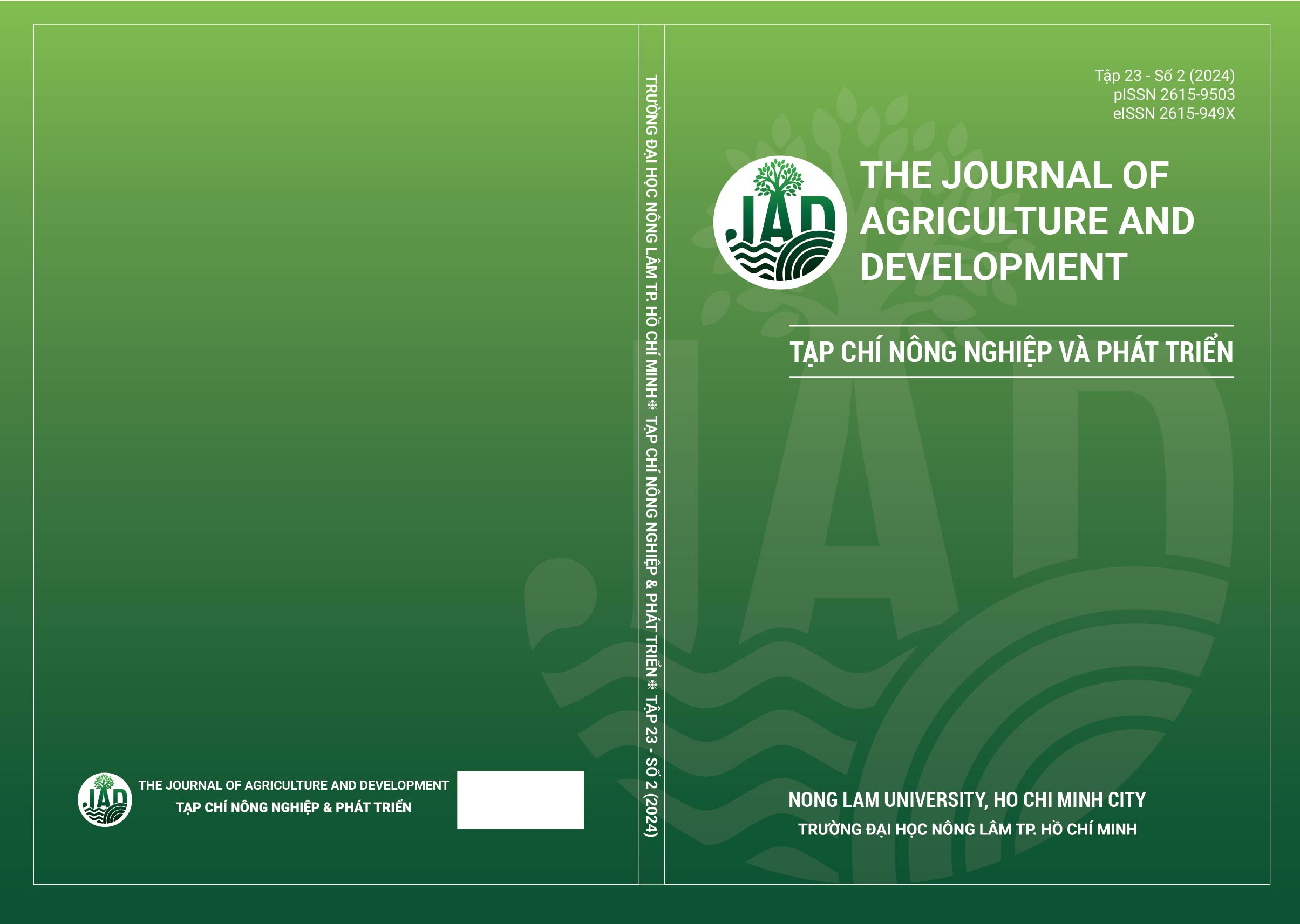Antibacterial activity of the black soldier fly (Hermetia illucens) larva protein hydrolysates against some pathogenic bacterial strains on freshwater fish
Main Article Content
Abstract
The study was carried out to determine the antibacterial activity of protein hydrolysates from black soldier fly (Hermetia illucens) larva (PHBSF) on some pathogenic bacteria including E. ictaluri, A. hydrophila, A. verroni, and S. agalactiae on freshwater fish. The results showed that the tested bacteria were highly sensitive with significant difference (P < 0.05) in diameter clear zone compared to the negative control at the tested concentrations of 20, 35, and 70 mg/100 µL. Particularlly, E. ictaluri was sensitive at all three test concentrations with the diameter of clear zones following 14.0 ± 1.0, 18.7 ± 0.7, and 20.7 ± 0.7 mm, respectively. A. veronii and S. agalactiae were sensitive at concentrations of 35 and 70 mg/100 µL, and A. hydrophila with a clear zone diameter of 14.3 ± 0.3 mm at the concentration of 70 mg/100 µL. The PHBSF was able to kill A. veronii and S. agalactiae with MIC (minimum inhibitory concentration) = MBC (minimum bactericidal concentration) = 44 mg/mL, while E. ictaluri and A. hydrophila were inhibited at MIC 44 mg/mL, and MBC was 88 mg/mL. These results indicated that PHBSF could be potentially used to prevent fish diseases caused by E. ictaluri, A. hydrophila, A. verroni, and S. agalactiae.
Article Details
References
Abduh, M. Y., Prawitasari, D. A., Fitrian, U. A., & Firmansyah, M. (2023). Effects of enzymatic hydrolysis on the antioxidant activity of protein hydrolysate derived from the larvae of black soldier fly (Hermetia illucens). Journal of Applied Biology and Biotechnology 11(2), 151-157. https://doi.org/10.7324/JABB.2023.110215.
Banks, I. J., Gibson, W. T., & Cameron, M. M. (2014). Growth rates of black soldier fly larvae fed on fresh human faeces and their implication for improving sanitation. Tropical Medicine International Health 19(1), 14-22. https://doi.org/10.1111/tmi.12228.
Canillac, N., & Mourey, A. (2001). Antibacterial activity of the essential oil of picea excelsa on listeria, Staphylococcus aureus and coliform bacteria. Food Microbiology 18(3), 261-268. https://doi.org/10.1006/fmic.2000.0397.
Chen, Y., Chi, S., Zhang, S., Dong, X., Yang, Q., Liu, H., & Xie, S. (2021). Evaluation of the dietary black soldier fly larvae meal (Hermetia illucens) on growth performance, intestinal health, and disease resistance to Vibrio parahaemolyticus of the Pacific White Shrimp (Litopenaeus vannamei). Frontiers in Marine Science 8, 706463. https://doi.org/10.3389/fmars.2021.706463.
Choi, W. H., Choi, H. J., Goo, T. W., & Quan, F. S. (2018). Novel antibacterial peptides induced by probiotics in Hermetia illucens (Diptera: Stratiomyidae) larvae. Entomological Research 48(4), 237-247. https://doi.org/10.1111/1748-5967.12259.
Čičková, H., Newton, G. L., Lacy, R. C., & Kozánek, M. (2015). The use of fly larvae for organic waste treatment. Waste Management 35, 68-80. https://doi.org/10.1016/j.wasman.2014.09.026.
Crumlish, M., Dung, T. T., Turnbull, J. F., Ngoc, N. T. N., & Ferguson, H. W. (2002). Identification of Edwardsiella ictaluri from diseased freshwater catfish, Pangasius hypophthalmus (Sauvage), cultured in the Mekong Delta, Vietnam. Journal of Fish Diseases 25(12), 733-736. https://doi.org/10.1046/j.1365-2761.2002.00412.x.
Ehsan, R., Rahman, A., Paul, S. I., Ador, M. A. A., Haque, M. S., Akter, T., & Rahman, M. M. (2023). Aeromonas veronii isolated from climbing perch (Anabas testudineus) suffering from epizootic ulcerative syndrome (EUS). Aquaculture and Fisheries 8(3), 288-295. https://doi.org/10.1016/j.aaf.2021.11.005.
Elhag, O., Zhou, D., Song, Q., Soomro, A. A., Cai, M., Zheng, L., & Zhang, J. (2017). Screening, expression, purification and functional characterization of novel antimicrobial peptide genes from Hermetia illucens (L.). PloS One 12(1), e0169582. https://doi.org/10.1371/journal.pone.0169582.
Epand, R. M., & Vogel, H. J. (1999). Diversity of antimicrobial peptides and their mechanisms of action. Biochimica et Biophysica Acta (BBA)-Biomembranes 1462(1-2), 11-28. https://doi.org/10.1016/S0005-2736(99)00198-4.
Harlystiarini, H., Mutia, R., Wibawan, I. W. T., & Astuti, D. A. (2019). In vitro antibacterial activity of black soldier fly (Hermetia illucens) larva extracts against gram-negative bacteria. Buletin Peternakan 43(2), 125-129. https://doi.org/10.21059/buletinpeternak.v43i2.42833.
Inglis, V., Roberts, R. J., & Bromage, N. R. (1993). Bacterial diseases of fish. New York, USA: Halsted Press.
Lee, D. H., Chu, K. B., Kang, H. J., Lee, S. H., & Quan, F. S. (2020). Peptides in the hemolymph of Hermetia illucens larvae completely inhibit the growth of Klebsiella pneumonia in vitro and in vivo. Journal of Asia-Pacific Entomology 23(1), 36-43. https://doi.org/10.1016/j.aspen.2019.10.004.
MITV (Ministry of Industry and Trade of Vietnam). (2022). Developing Vietnam’s seafood industry to adapt to the new situation. Retrieved May 20, 2023, from https://moit.gov.vn/tin-tuc/thitruong-trong-nuoc/phat-trien-nganh-thuysan-viet-nam-thich-ung-voi-tinh-hinh-moi.html.








